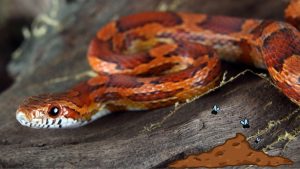Understanding the Growth and Size of Corn Snakes
Corn snakes are a popular species of pet snake due to their docile nature, attractive coloration, and manageable size. However, one important consideration for anyone thinking of owning a corn snake is how big they can get. In this article, we will explore the growth patterns of corn snakes and answer the question, “how big does a corn snake get?”
Corn snakes are a species of rat snake native to the southeastern United States. They are relatively small snakes, with adults typically reaching between 3 and 5 feet in length. However, as with all living creatures, there is variation in size among individuals. Some corn snakes may be slightly smaller or larger than this average size range. Additionally, factors such as diet and environment can influence a corn snake’s growth rate. By understanding the typical growth patterns of corn snakes, owners can better anticipate their pet’s needs and provide appropriate care.
Corn Snake Size
As snake enthusiasts, we know that one of the most important factors to consider when owning a corn snake is their size. In this section, we will discuss the growth rate, adult size, and juvenile size of corn snakes.
Growth Rate
Corn snakes are known for their slow and steady growth rate. According to PetKeen, corn snakes do not experience any dramatic growth spurts and can go months without any noticeable difference in size. The growth rate of corn snakes can be affected by various factors such as diet, temperature, and environment.
Adult Size
When it comes to adult size, corn snakes can vary somewhat, but on average, they reach a length of 4-5 feet (120-150cm) and weigh about 1 to 2 pounds. However, some exceptional corn snakes can reach up to 6 feet in length. According to LoveToKnowPets, males are usually longer and larger than females at maturity, but this is not always a reliable way to differentiate the sexes.
Juvenile Size
Corn snakes start small, with hatchlings measuring between 8-12 inches in length. According to Terrarium Quest, their growth starts immediately after hatching but proceeds gradually. They reach up to full size in two to three years, with weight ranging between 1-2 pounds, and remain there for the rest of their lives.
Growth Chart
It’s essential to keep track of your corn snake’s growth to ensure they are healthy and thriving. A growth chart can help you monitor your snake’s progress and identify any potential issues. You can find corn snake growth charts online, such as the one provided by VivoPets.
In conclusion, understanding the size of your corn snake is crucial for their health and well-being. By monitoring their growth rate and keeping track of their size, you can ensure that your snake is healthy and happy.
Diet and Habitat
Food
As with all reptiles, a corn snake’s diet is crucial to its health. In the wild, corn snakes primarily eat rodents such as rats and mice, but they may also consume amphibians and bird eggs. In captivity, owners can feed their pet snakes live or frozen rodents, such as mice or quail eggs. It is important to note that live prey can be harmful to the snake and should be handled with care.
Habitat
Corn snakes are native to the southeastern United States, from Florida to the western parts of Louisiana and Texas. They prefer forest openings and grain stores, where they can hunt for wild rodent pests. In captivity, corn snakes need a tank that is at least 30 gallons in size. The tank should have logs and trees for climbing, as well as a hiding spot for the snake to feel secure.
Temperature
Corn snakes are ectothermic, which means they rely on external sources of heat to regulate their body temperature. In the wild, they bask in the sun to raise their body temperature and hide in the shade to cool down. In captivity, owners should provide a heat lamp to maintain a temperature of 78-82°F in the tank. A basking surface of 90°F and a cool zone of 75°F should also be established to allow the snake to regulate its body temperature.
Humidity
Corn snakes require a humidity level of 40-60% in their tank. This can be achieved by misting the tank with water or providing a water dish for the snake to soak in. It is important to monitor the humidity level regularly, as low humidity can cause shedding problems and stress for the snake.
Overall, corn snakes are docile and calm pets that can be easily cared for. With proper diet, habitat, temperature, and humidity, they can live up to 23 years in captivity. While they may resemble the venomous copperhead, corn snakes are harmless and are often cared for as pet snakes due to their attractive colors and patterns.
Handling and Behavior
When it comes to handling a corn snake, there are a few things to keep in mind. Corn snakes are generally docile and make great pets, but like all animals, they have their own unique personalities. Here are some things to keep in mind when handling your corn snake.
Docility
Corn snakes are generally docile and make great pets for beginners. They are not venomous and are not aggressive towards humans. However, it is important to remember that each snake has its own personality and some may be more skittish or nervous than others. It is important to handle your corn snake regularly to help it become more comfortable with you.
Activity
Corn snakes are generally active at night and can be quite active when they are hungry. They are also known to be good climbers and may try to climb out of their enclosure if they are not provided with enough hiding spots and climbing opportunities. It is important to provide your corn snake with plenty of hiding spots and climbing opportunities to keep them active and stimulated.
Stress
Like all animals, corn snakes can become stressed if they are not provided with the proper care and environment. Signs of stress in corn snakes can include refusing to eat, hiding more than usual, and becoming more aggressive. It is important to provide your corn snake with the proper care and environment to keep them happy and healthy.
Handling
When handling your corn snake, it is important to be gentle and calm. Corn snakes are generally docile, but they can become nervous if they are handled too roughly or if they feel threatened. It is important to support your corn snake’s body when you pick them up and to avoid sudden movements. It is also important to wash your hands before and after handling your corn snake to prevent the spread of bacteria.
Overall, corn snakes are great pets and are generally docile and easy to handle. It is important to provide them with the proper care and environment to keep them happy and healthy. With proper care and handling, your corn snake can live a long and healthy life.
Frequently Asked Questions
What is the average size of a full grown corn snake?
The average size of a full grown corn snake can range from 3 to 5 feet long and weigh around 1 to 2 pounds. However, some corn snakes can grow up to 6 feet long. It is important to note that the size of a corn snake can depend on several factors, including genetics, diet, and environment.
How often should I feed my corn snake?
Corn snakes should be fed once every 5 to 7 days, depending on their age and size. Younger snakes may need to be fed more frequently, while adult snakes may only need to be fed once every 7 to 10 days. It is important to feed your corn snake a diet of appropriately sized rodents, such as mice or rats.
What kind of food do corn snakes eat?
Corn snakes are carnivorous and primarily eat rodents, such as mice and rats. It is important to feed your corn snake a diet of appropriately sized prey, as feeding them prey that is too large can cause health problems.
Are corn snakes dangerous?
Corn snakes are not dangerous to humans. They are non-venomous and are not aggressive. However, like all animals, corn snakes can bite if they feel threatened or are handled improperly. It is important to handle your corn snake gently and with care to avoid being bitten.
How long do corn snakes live?
Corn snakes can live for up to 20 years in captivity with proper care. However, their lifespan can be affected by several factors, including genetics, diet, and environment.
Is a corn snake a good pet?
Corn snakes can make great pets for those interested in owning a snake. They are relatively easy to care for and are docile in nature. However, it is important to do your research before getting a corn snake to ensure that you can provide them with the proper care and environment they need to thrive.
Author
-

Lawrence, the founder of Pet Ploy, established the website in mid-2023. With a lifelong love for pets, Lawrence has been surrounded by a variety of animals since his early years. From dogs and cats to guinea pigs, rabbits, fish, and more, he has experienced the joy of caring for a diverse range of pets. Drawing from his deep-rooted passion, Lawrence created Pet Ploy to share his knowledge and enthusiasm with fellow pet enthusiasts. Through the platform, he aims to provide valuable insights, tips, and resources to promote the well-being and happiness of pets everywhere.











